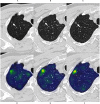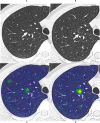Baseline whole-lung CT features deriving from deep learning and radiomics: prediction of benign and malignant pulmonary ground-glass nodules
- PMID: 37664069
- PMCID: PMC10470826
- DOI: 10.3389/fonc.2023.1255007
Baseline whole-lung CT features deriving from deep learning and radiomics: prediction of benign and malignant pulmonary ground-glass nodules
Abstract
Objective: To develop and validate the model for predicting benign and malignant ground-glass nodules (GGNs) based on the whole-lung baseline CT features deriving from deep learning and radiomics.
Methods: This retrospective study included 385 GGNs from 3 hospitals, confirmed by pathology. We used 239 GGNs from Hospital 1 as the training and internal validation set; 115 and 31 GGNs from Hospital 2 and Hospital 3 as the external test sets 1 and 2, respectively. An additional 32 stable GGNs from Hospital 3 with more than five years of follow-up were used as the external test set 3. We evaluated clinical and morphological features of GGNs at baseline chest CT and extracted the whole-lung radiomics features simultaneously. Besides, baseline whole-lung CT image features are further assisted and extracted using the convolutional neural network. We used the back-propagation neural network to construct five prediction models based on different collocations of the features used for training. The area under the receiver operator characteristic curve (AUC) was used to compare the prediction performance among the five models. The Delong test was used to compare the differences in AUC between models pairwise.
Results: The model integrated clinical-morphological features, whole-lung radiomic features, and whole-lung image features (CMRI) performed best among the five models, and achieved the highest AUC in the internal validation set, external test set 1, and external test set 2, which were 0.886 (95% CI: 0.841-0.921), 0.830 (95%CI: 0.749-0.893) and 0.879 (95%CI: 0.712-0.968), respectively. In the above three sets, the differences in AUC between the CMRI model and other models were significant (all P < 0.05). Moreover, the accuracy of the CMRI model in the external test set 3 was 96.88%.
Conclusion: The baseline whole-lung CT features were feasible to predict the benign and malignant of GGNs, which is helpful for more refined management of GGNs.
Keywords: X-ray computed; deep learning; ground-glass nodules; lung cancer; radiomics; tomography.
Copyright © 2023 Huang, Deng, Li, Xiong, Zhou, Ge, Zhang, Jing, Geng, Wang, Tu, Dong, Liu and Fan.
Conflict of interest statement
Author ZX was employed by Tron technology. Author YYG was employed by Shukun Beijing Technology Co., Ltd. The remaining authors declare that the research was conducted in the absence of any commercial or financial relationships that could be construed as a potential conflict of interest.
Figures






Similar articles
-
Prediction of benign and malignant ground glass pulmonary nodules based on multi-feature fusion of attention mechanism.Front Oncol. 2024 Oct 9;14:1447132. doi: 10.3389/fonc.2024.1447132. eCollection 2024. Front Oncol. 2024. PMID: 39445066 Free PMC article.
-
Computed tomography radiomics in growth prediction of pulmonary ground-glass nodules.Eur J Radiol. 2023 Feb;159:110684. doi: 10.1016/j.ejrad.2022.110684. Epub 2022 Dec 31. Eur J Radiol. 2023. PMID: 36621209 Clinical Trial.
-
Computer-aided diagnosis of ground glass pulmonary nodule by fusing deep learning and radiomics features.Phys Med Biol. 2021 Mar 4;66(6):065015. doi: 10.1088/1361-6560/abe735. Phys Med Biol. 2021. PMID: 33596552
-
CT-based radiomics for differentiating invasive adenocarcinomas from indolent lung adenocarcinomas appearing as ground-glass nodules: Asystematic review.Eur J Radiol. 2021 Nov;144:109956. doi: 10.1016/j.ejrad.2021.109956. Epub 2021 Sep 17. Eur J Radiol. 2021. PMID: 34563797 Review.
-
[Artificial intelligence research advances in discrimination and diagnosis of pulmonary ground-glass nodules].Zhonghua Jie He He Hu Xi Za Zhi. 2024 Jun 12;47(6):566-570. doi: 10.3760/cma.j.cn112147-20231214-00370. Zhonghua Jie He He Hu Xi Za Zhi. 2024. PMID: 38858209 Review. Chinese.
Cited by
-
A CT-Based Lung Radiomics Nomogram for Classifying the Severity of Chronic Obstructive Pulmonary Disease.Int J Chron Obstruct Pulmon Dis. 2024 Dec 11;19:2705-2717. doi: 10.2147/COPD.S483007. eCollection 2024. Int J Chron Obstruct Pulmon Dis. 2024. PMID: 39677830 Free PMC article.
-
Predicting invasion in early-stage ground-glass opacity pulmonary adenocarcinoma: a radiomics-based machine learning approach.BMC Med Imaging. 2024 Sep 13;24(1):240. doi: 10.1186/s12880-024-01421-2. BMC Med Imaging. 2024. PMID: 39272029 Free PMC article.
-
CT-Based radiomics nomogram of lung and mediastinal features to identify cardiovascular disease in chronic obstructive pulmonary disease: a multicenter study.BMC Pulm Med. 2025 Mar 15;25(1):121. doi: 10.1186/s12890-025-03568-2. BMC Pulm Med. 2025. PMID: 40089791 Free PMC article.
-
CT-based whole lung radiomics nomogram: a tool for identifying the risk of cardiovascular disease in patients with chronic obstructive pulmonary disease.Eur Radiol. 2024 Aug;34(8):4852-4863. doi: 10.1007/s00330-023-10502-9. Epub 2024 Jan 12. Eur Radiol. 2024. PMID: 38216755
-
A multimodal nomogram for benign-malignant discrimination of lung-RADS ≥4A nodules: integration of oxygen enhanced zero echo time MRI, CT radiomics, and clinical factors.Front Oncol. 2025 Jul 21;15:1563073. doi: 10.3389/fonc.2025.1563073. eCollection 2025. Front Oncol. 2025. PMID: 40761252 Free PMC article.
References
LinkOut - more resources
Full Text Sources

